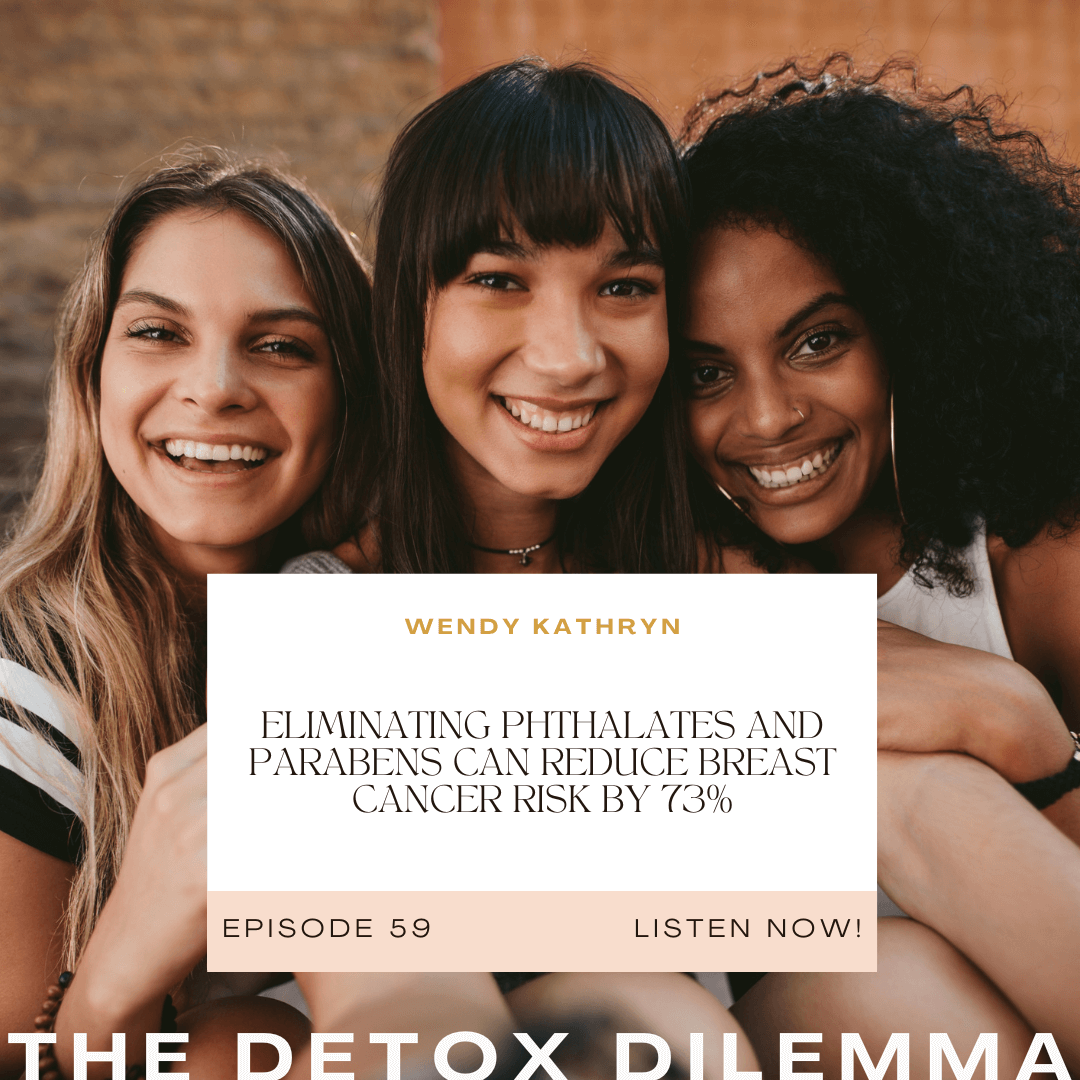Eliminating Phthalates and Parabens Can Reduce Breast Cancer Risk by 73%
What if I told you that one small change in your daily routine could significantly decrease your future risk factors for breast cancer by 73% in as little as 28 days?
Breast cancer rates are rising, especially among younger women. I want to share some truly inspiring insight into the future of breast cancer prevention with a first-of-its-kind, intervention study showing that you really can significantly reduce your risk of breast cancer by doing something as simple as swapping to clean products.
In this episode, I'm going to share the incredible details of the study and give some simple tips on how to implement these small changes that can make a big difference to your health and your home. It's so much simpler than you think.
In This Episode:
Breast Cancer States
New study and research on breast cancer causes and risks
Breast Cancer Stats
One in eight women will be diagnosed with breast cancer at some point in their lives. Forty years ago, that number was one in twenty women, so rates are rising, and they're rising exponentially among younger women. We know that only 10-15% of all breast cancers come from women to have a family history of breast cancer. They're genetically inclined and have a predisposition.
That leaves 85-90% of all other breast cancers being attributed to environmental factors, lifestyle, diet, and use of products.
That's a good thing, right? That's empowering. It means there are things we can do to decrease our risk of breast cancer. But it also means there are so many environmental factors out there that can contribute to our risk.
I've worked with over 800 families, and they all say the same thing. It is really difficult to make changes in your life if you don't believe they will make a difference.
If you’re eating healthier or you're no longer using personal care products or cosmetics that have ingredients that are known to contribute to your risk of breast cancer, you might think, “Do I have to do that? Do I have to give it up? Am I going to possibly get breast cancer anyway? Is it going to make a difference?”
What I love so much about this study is it’s so specific to individual women. What is your risk of breast cancer? What are the markers that show an increased risk, and then what happens if you make simple changes?
The study retested participants 28 days later and found what happened to their bodies. This is the first of its kind; no study has ever been done like this. As somebody who works in environmental toxins regulation, this is also a huge game changer when it comes to regulating environmental toxins. Historically, the dose is the way all chemicals have been regulated. If you come into contact with it, is there an immediate reaction? Are you going to pass out? Is it so toxic that they can see immediate neurological damage? What are the acute reactions that people have?
Proving that long-term low-dose exposure to a specific chemical causes harm is difficult. The companies that produce these chemicals and the companies that use them in their products can point to other things and divert the attention away from their ingredients. They’ll claim it was the user’s lifestyle, diet, predisposition, or other factors that caused their breast cancer. There are so many other factors proving something truly does harm that it becomes difficult to prove.
Studies like this can help get laws and regulations passed. It shows that yes, there is a causation between the two. That could truly change the face of regulation in the future.
The Study on Breast Cancer
The study revolves around the use of personal care products (shampoo, conditioner, lotion, deodorant, etc.) that contain two specific ingredients: parabens and phthalates. Those two chemicals were chosen for two reasons:
There is a lot of well-established data out there showing that those two ingredients, in particular, are highly estrogenic. We know having that extra estrogenic activity leads to an increased risk of breast cancer.
They're pervasive in everything. People are getting smarter about parabens, and a lot of companies have started removing their parabens. However, most products on the market still contain synthetic fragrances and likely contain phthalates.
Forty-one women participated in the study. They were cancer-free, and before starting the study, researchers collected blood, urine, and breast tissue cells from the participants. The researchers had the women swap all of their products out. They got rid of any personal care product with a phthalate or paraben in it. To ensure all the women had the same thing, they provided them with products. These were the products:
Deodorant - Schmitz
Bar soap - Luminance
Toothpaste - Toms
Lip balm - Badger
Sunscreen - Beautycounter
Makeup - Mineral Fusion and Pacifica
Liquid soap - Dr. Browner
Silicone containers for their products
All the women in the study agreed to use all of these products for 28 days. They stopped using their current products and only used these products for 28 days. It was the only intervention that happened.
You could see in their blood and urine samples that the number of markers for things like phthalates and parabens was reduced significantly during that time. That is the thing about parabens and phthalates; they don't live in your body for a very long time. The issue is that people are putting them on their bodies all day, every day, so they remain in our system. They never get a chance to leave.
Leading up to the study, we've had a glimpse of some of this. Higher personal care use with parabens in them was always associated with higher urinary levels of parabens. There was another study that showed that 60% of Methylparaben (a lot of deodorants have this) gets into your breast tissue. They could measure that and the amount of phthalates in breast tissue, breast milk, blood, urine, and amniotic fluids.
We also had some research that showed pre-diagnostic urinary phthalates. The amount of phthalates that are in a woman's urine was higher in women who developed breast cancer. We always had these correlations, but closing the gap into causation was always something missing.
Here's what happened - not only did the phthalate levels and paraben levels significantly decrease in blood and urine, but they also observed a 73% reversal of known cancer-associated cell signaling pathways in the breast tissue.
I will not pretend that I know or understand anything about the way this was done. It's basically the gene expression that shows a high-risk or normal profile. High risk just means they're at higher risk for developing breast cancer.
Here’s a link to the study if you want to nerd out.
I am trying so hard to bring awareness and teach people that small changes can make a big impact. This study is huge. If you're listening to this and you are so ready to make some changes, check out my toxin-free shopping guide. It has a list of all of my fully vetted toxin-free products. None of them have parabens, phthalates, or any endocrine disruptor in them.
Doors are also officially open for my signature course, Toxin Free in 3. I would love to have you join me.
I hope you share this episode with every single woman in your life.
If you enjoyed this week's episode, please:
Leave a positive review or rating wherever you listen
Shop toxin-free products on my Toxin Free Shopping Guide
Download your free Tossing the Toxins Guide
Post a screenshot, what you loved from the episode, and tag me on Instagram @wendy_toxinfreeish
Want to ask me a question to get answered on the podcast? Leave me a voice message here.
Related Episodes:
Episode 55: Breast Implant Illness is Real, Not Rare, with Robyn Towt & Amanda Porta
Episode 23: Why Did I Get Cancer? with Deborah Enos















